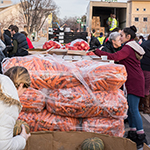Ahh, fall. The air is cooler, the leaves are changing and new foods are in season. Celebrate autumn by heading to your local market and filling your basket with these seasonal gems. Fresh fall produce is a great source of fiber, antioxidants and phytochemicals, which promote health and can be protective against disease. The variation of rich colors like orange and red (beta carotene) and green (chlorophyll) are great sources of vitamin C, A, and K, folic acid, potassium and carotenoids. Want to know how you can incorporate some of these fall-favorites into your diet? Read on for seasonal cooking tips.
 PUMPKIN (HARVEST SEASON: OCTOBER–FEBRUARY)
PUMPKIN (HARVEST SEASON: OCTOBER–FEBRUARY)
Pumpkin spice… makes everything nice. Try adding a dollop of pumpkin puree to your oatmeal, smoothie or hummus for a fall-inspired dip. A simple puree of pumpkin, coconut milk and warm spices makes for a delicious and easy pumpkin soup to serve as the temperatures begin to drop. Pumpkin also makes a great addition to no-bake energy bites (recipe on page 3!).
WINTER SQUASH (HARVEST SEASON: OCTOBER– FEBRUARY)
Fall is the perfect time to dig into those colorful squashes—each has their own unique flavor and texture. To prepare squash, simply slice one in half, scoop out the pocket of seeds, drizzle with olive oil and seasonings and pop the two halves into the microwave for 10-12 minutes (or roast in the oven at 400˚F for 50-60 minutes until tender). Butternut squash works especially well
in soups, purees or even roasted and added to salads. Spaghetti squash can be steamed and used in place of pasta served with a veggie-rich sauce. Try stuffing acorn squash with savory vegetables, spiced whole grains and dried fruit to eat as a hearty, warming meal.
 KALE (HARVEST SEASON: YEAR-ROUND, PEAKS DURING FALL AND WINTER)
KALE (HARVEST SEASON: YEAR-ROUND, PEAKS DURING FALL AND WINTER)
Kale has gotten a bad rap for being roughage, but don’t write it off right away. Try massaging kale with oil and salt to break down some of the bitterness for salad or throw it into a smoothie with some strawberry and pineapple to cut the bite. You can also make homemade kale chips by ripping the leaves into small pieces and microwaving for 2-3 minutes until crispy. It’s that easy! Try experimenting with different olive oils and seasonings before microwaving for more flavor.
BEETS (HARVEST SEASON: JUNE THROUGH OCTOBER)
Not sure what to do with those beets you always see at the market? Try throwing roasted beets over a salad and toss with fruit and a vinaigrette for beautiful color and flavor. You can also bake them into beet fries, slice and serve them in a sandwich, try beet-potato-hash, or blend beets into a soup or smoothie. When you’re preparing your beets save the green leafy tops for salads, sautées and green smoothies!
 PEARS (HARVEST SEASON: AUGUST–FEBRUARY)
PEARS (HARVEST SEASON: AUGUST–FEBRUARY)
Pears are another yummy fall fruit to enjoy. Throw pears, cinnamon, nuts, oats and milk into a mason jar and let sit overnight for a fall-infused, ready- to-go breakfast. Baked pears, ricotta cheese and a sprinkling of cinnamon makes for a delicious low- calorie, protein-packed dessert. Blend pears and
parsnips together for a sweet and earthy fall harvest soup.
APPLES (HARVEST SEASON: AUGUST- NOVEMBER)
 Did you know there are more than 7,500 varieties of apples? For a fun spin on your regular apple dipping, try cutting the apple into thin slices and top with nut butter, granola and other toppings of your choice. If you are slicing them to eat as a snack later, squeeze some lemon or lime juice over the apples to keep them from browning. You can also make
Did you know there are more than 7,500 varieties of apples? For a fun spin on your regular apple dipping, try cutting the apple into thin slices and top with nut butter, granola and other toppings of your choice. If you are slicing them to eat as a snack later, squeeze some lemon or lime juice over the apples to keep them from browning. You can also make
quick homemade applesauce by boiling apples and throwing them into a blender with desired spices, including nutmeg, cinnamon, allspice, vanilla, maple or brown sugar. Use apples in soups, pancakes, marinades, crepe filling, stuffing, dehydrated as chips
or paired on a toothpick with cheese for a savory snack. Be sure to stock up on this fruit and preserve any extras for the winter months because the
possibilities here are endless!



































































































